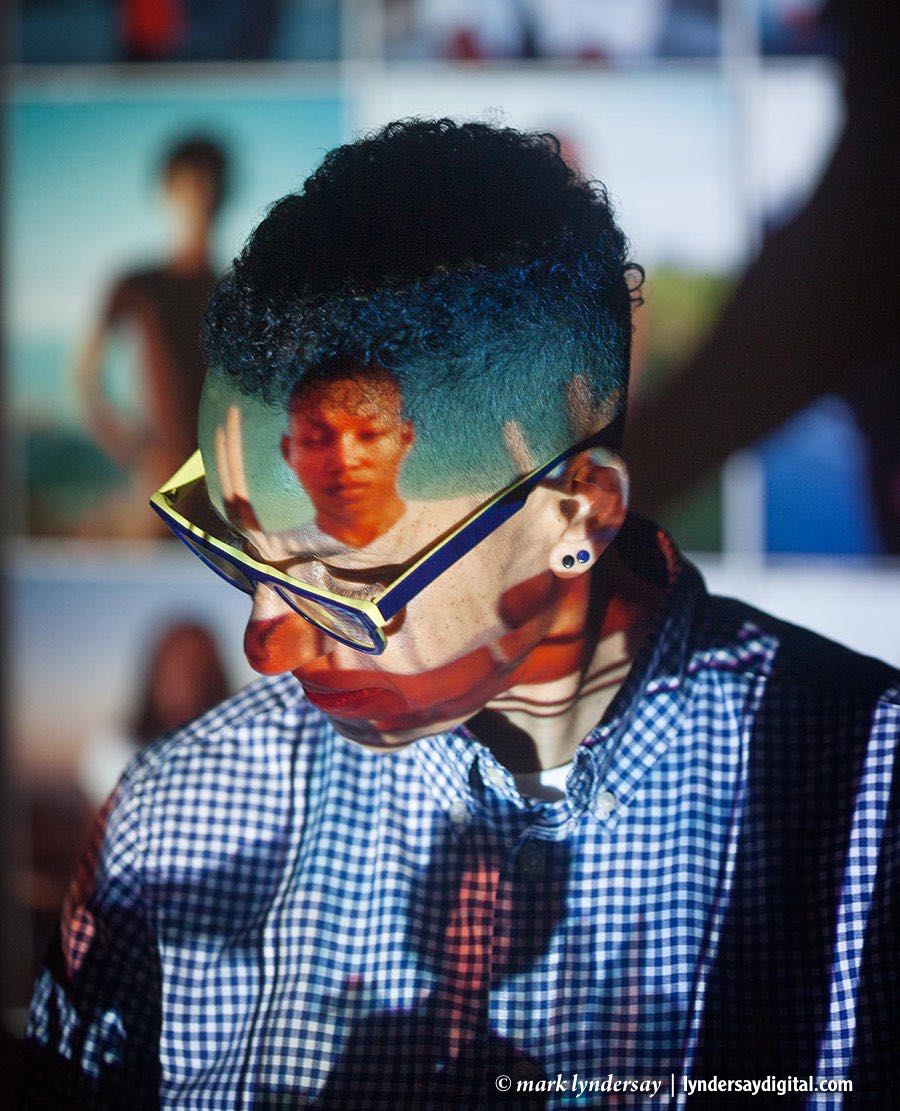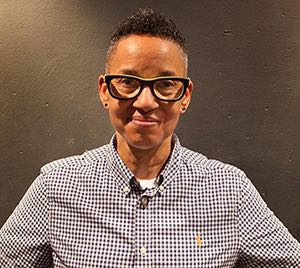The Lola Flash portrait
17/04/17 18:56 Filed in: Interview

Photographer Lola Flash photographed by the light of her projected work at Alice Yard. Photograph by Mark Lyndersay. Click to enlarge images in the body of the text.
Originally published in the T&T Guardian for August 07, 2015
Lola Flash isn’t someone who stands out in a crowd. She’s a woman of medium height and close cropped hair who hides her bright eyes behind huge glasses.
Not so her portraits of people.
Flash, in Trinidad from July 27 to August 18 as an artist in residence at Alice Yard, will be pursuing three of her portrait series over the next couple of weeks and her shooting schedule seems set to fill quickly.
Salt is a collection of environmental portraits of iconic older women in their homes. The photographer is looking for subjects who are 70 and older who have had a quiet impact on their respective worlds.
For [sur]mise, she hopes to connect with, in the words of the Alice Yard prospectus introducing her visit, “girls who look like boys, straights who look like gays and visa versa.
She also hopes to add work to her [sur]passing series, which considers the question of “pigmentocracy,” a work she describes as cathartic for a light skinned person who has had to answer the interrogative, “Are you black? Are you African-American?
Flash, who has changed her name formally and prefers not to get into the circumstances of it, works with a Toyo 4”x 5” camera and Fuji Provia film, illuminating her work with strobe sources.
“Buying film and processing have both provided challenges, but it doesn't dissuade me from shooting this format,” she said.
The [sur]passing work fits squarely into modern confrontational art portraiture. Shot at close range with a normal lens and framed to crop at the subject’s upper thigh, the subjects, set squarely in the middle of the frame are surrounded by backgrounds that drift at the boundary of perception in the distance, unified by a horizon line that bisects them all at a point close to the middle of the height of the image.
“I would love to do it at the Guggenheim, starting with the bottom with lighter skinned people and winding all the way to the top with darker skinned people, subverting the traditional notions of colour bias,” Flash said during a talk about her work at Alice Yard on July 30.
“The work, when mounted, matches the horizon lines and it looks like all these people inhabit the same world.”
The [sur]mise series uses the same cropping and framing technique but uses a white background. Most of the subjects wear stark black and the posing tends to be more aggressive in these images, but only subtly so.
Unsurprisingly, the photographer began working almost immediately on Salt, with several members of the audience posing leading questions about the project during her talk.
It seems everybody’s got a favorite tanty who would be right for the portrait project and nobody’s shy about proposing a subject.
That’s likely to dovetail neatly into the motivations of Lola Flash in pursuing the project. For her, family is important and she still has fond memories of being cared for by her grandparents.
“Salt is about shedding light on women who often don’t get that light,” she said, “women who are opinionated, in control and perhaps a little eccentric.”
After attending the Maryland Institute of Art, Flash began 20 years of working with negatives, doing work that, as inverted colour values and scrambled the conceptions of her images.
The work didn’t have a robust response from the arts community, though she employed the technique to explore issues related to the social impact of the AIDS epidemic.
“I’m still not clear why it never anywhere,” she admits, “I’ve never interrogated the response to it.”
After a failed relationship, she visited England and ended up staying in London for eight years, working for alternative lifestyle publications there.
That’s where she created the Gay A-Z and began working in colour positive materials.
It’s also where the ideas in [sur]passing were born when she found herself described as “the mixed race girl,” and she began considering the interventions that skin colour has on lifestyles and job accessibility.
Both that series and the later [sur]mise explore her comfort with the way she looks and the person she is. The images seek out that confidence in others even as they challenge common public perceptions of her subjects.
“I aim to make portraits of marginalised people, like myself,” she said.
“I want to expose our beauty in a way that is not always shown to the public. These are the people that have made us proud, supported us and made it possible most for us to exist, yet society-at-large deems [them] invisible.”
While Lola Flash has staked out portraiture as her medium, she showed to other series at Alice Yard, Scents of Autumn, photographs about pure colour and texture, and The Quartet series, overtly influenced by Piet Mondrian, which juxtaposes store fronts from countries she visits in riveting quadtychs that explore similarities in style, colour and texture.
“I thought I'd never take another beautiful picture until the AIDS crisis is over,” she said, “then I began to rethink that when she hit 50 and realised I had a license to relax. I needed to stop, to just breathe.”
But Lola Flash hasn’t come to T&T for a vacation. She intends to take photographs and a lot of them.
“So far, my reception has been very warm,” Flash noted in a follow up email.
“I'm hoping for a big turn out this weekend, 7-9 August, at Alice Yard, for my [sur]mise series.”
“I've decided it would be best to have a 'drop-in' set up, so people can come when it's best for them. I've shot one older lady an she was super lovely, her sister-in-law is looking for more women, and tomorrow, I have a shoot for [sur]passing, so I'm pretty excited!”
blog comments powered by Disqus

